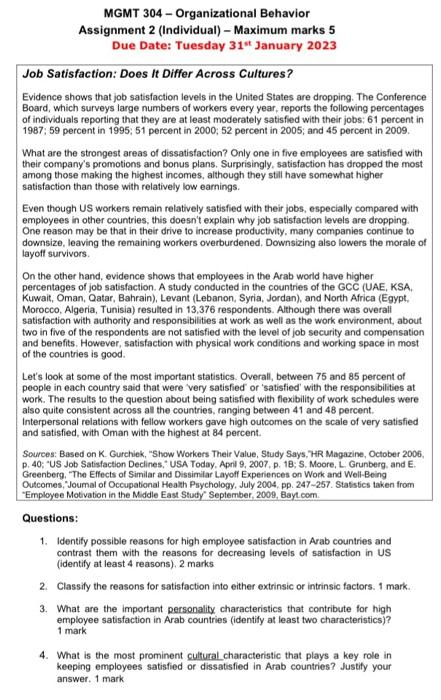Answered step by step
Verified Expert Solution
Question
1 Approved Answer
Answer all the questions of this case And the answers I want them very long MGMT 304 - Organizational Behavior Assignment 2 (Individual) - Maximum
Answer all the questions of this case
MGMT 304 - Organizational Behavior Assignment 2 (Individual) - Maximum marks 5 Due Date: Tuesday 31st January 2023 Job Satisfaction: Does It Differ Across Cultures? Evidence shows that job satisfaction levels in the United States are dropping. The Conference Board, which surveys large numbers of workers every year, reports the following percentages of individuals reporting that they are at least moderately satisfied with their jobs: 61 percent in 1987; 59 percent in 1995; 51 percent in 2000; 52 percent in 2005; and 45 percent in 2009. What are the strongest areas of dissatisfaction? Only one in five employees are satisfied with their company's promotions and bonus plans. Surprisingly, satisfaction has dropped the most among those making the highest incomes, although they still have somewhat higher satisfaction than those with relatively low earnings. Even though US workers remain relatively satisfied with their jobs, especially compared with employees in other countries, this doesn't explain why job satisfaction levels are dropping. One reason may be that in their drive to increase productivity, many companies continue to downsize, leaving the remaining workers overburdened. Downsizing also lowers the morale of layoff survivors. On the other hand, evidence shows that employees in the Arab world have higher percentages of job satisfaction. A study conducted in the countries of the GCC (UAE, KSA, Kuwait, Oman, Qatar, Bahrain), Levant (Lebanon, Syria, Jordan), and North Africa (Egypt, Morocco, Algeria, Tunisia) resulted in 13,376 respondents. Although there was overall satisfaction with authority and responsibilities at work as well as the work environment, about two in five of the respondents are not satisfied with the level of job security and compensation and benefits. However, satisfaction with physical work conditions and working space in most of the countries is good. Let's look at some of the most important statistics. Overall, between 75 and 85 percent of people in each country said that were 'very satisfied or 'satisfied' with the responsibilities at work. The results to the question about being satisfied with flexibility of work schedules were also quite consistent across all the countries, ranging between 41 and 48 percent. Interpersonal relations with fellow workers gave high outcomes on the scale of very satisfied and satisfied, with Oman with the highest at 84 percent. Sources: Based on K. Gurchiek, "Show Workers Their Value, Study Says, HR Magazine, October 2006, p. 40; "US Job Satisfaction Declines., USA Today, Aprl 9, 2007, p. 18; S. Moore, L. Grunberg, and E. Greenberg. "The Effects of Similar and Dissimilar Layoff Experiences on Work and Well-Being Outcomes, "Joumal of Occupational Heath Psychology, July 2004, pp. 247-257. Stats6ics taken from "Employee Motvation in the Maddle East Study' September, 2009, Baycoom. Questions: 1. Identify possible reasons for high employee satisfaction in Arab countries and contrast them with the reasons for decreasing levels of satisfaction in US (identify at least 4 reasons), 2 marks 2. Classify the reasons for satisfaction into either extrinsic or intrinsic factors. 1 mark. 3. What are the important personality characteristics that contribute for high employee satisfaction in Arab countries (identify at least two characteristics)? 1 mark 4. What is the most prominent culturalcharacteristic that plays a key role in keeping employees satisfied or dissatisfied in Arab countries? Justify your answer. 1 mark And the answers I want them very long 

Step by Step Solution
There are 3 Steps involved in it
Step: 1

Get Instant Access to Expert-Tailored Solutions
See step-by-step solutions with expert insights and AI powered tools for academic success
Step: 2

Step: 3

Ace Your Homework with AI
Get the answers you need in no time with our AI-driven, step-by-step assistance
Get Started


